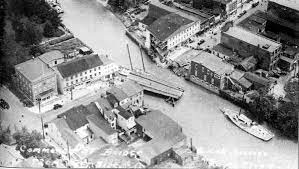On August 11, 1934, a devastating flood struck the United States, causing widespread destruction and loss of life. Known as the "Great Flood of 1934," this natural disaster affected several states in the Midwest, including Ohio, Indiana, Illinois, and Kentucky. The Great Flood of 1934 was triggered by a combination of heavy rainfall and saturated soil conditions. In the weeks leading up to the flood, a series of intense storms dumped significant amounts of rain onto an already waterlogged region. The excessive precipitation overwhelmed rivers and tributaries, causing them to overflow their banks and inundate surrounding areas. The floodwaters quickly engulfed towns and cities, leaving a trail of destruction in their wake. Homes, businesses, and infrastructure were submerged, and entire communities were displaced. The force of the floodwaters washed away bridges, dams, and roads, further exacerbating the impact of the disaster. The human toll of the Great Flood of 1934 was significant. Approximately 400 people lost their lives, and thousands were injured or displaced. The destruction of homes and infrastructure left many without shelter, food, or clean water. The flood also had devastating economic consequences, as crops, livestock, and industrial facilities were destroyed, leading to significant financial losses for individuals and communities. The response to the Great Flood of 1934 was a testament to the resilience and compassion of the American people. Local communities, government agencies, and relief organizations rallied together to provide aid and support to those affected. The American Red Cross played a critical role in providing emergency assistance, including shelter, food, and medical care, to flood victims. The federal government also stepped in to offer assistance and support. President Franklin D. Roosevelt declared the affected areas as disaster zones, allowing for federal resources and funding to be allocated for relief efforts. The Works Progress Administration (WPA) and the Civilian Conservation Corps (CCC) were mobilized to provide employment opportunities for those displaced by the flood, helping to rebuild damaged infrastructure and restore communities. The Great Flood of 1934 served as a catalyst for improvements in flood control and disaster response. In the aftermath of the disaster, the federal government and local authorities implemented measures to mitigate the risk of future floods. This included the construction of levees, dams, and reservoirs, as well as the establishment of flood forecasting and warning systems. The lessons learned from the Great Flood of 1934 also influenced national policies and legislation related to flood management. The disaster highlighted the need for comprehensive flood control measures and the importance of coordination between federal, state, and local agencies. It spurred the development of the National Flood Insurance Program, which provides financial protection to property owners in flood-prone areas. The Great Flood of 1934 remains a significant event in American history, reminding us of the destructive power of natural disasters and the resilience of communities in the face of adversity. The lessons learned from this tragic event have helped shape flood management practices and disaster response strategies, ensuring that communities are better prepared to face future challenges.
11 Aug, 1934 U.S.A. Flood
